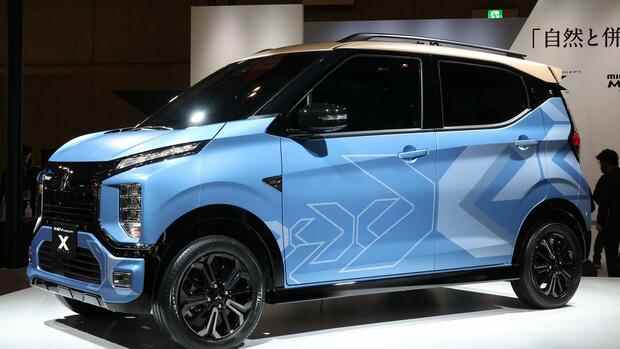The automaker is merging its platforms with those of Renault and Nissan.
(Photo: imago images/AFLO)
Paris, Tokyo The automaker alliance of Renault, Nissan and Mitsubishi wants to work more closely together on electric vehicles and invest around 23 billion euros over the next five years. By 2030, 35 new battery-powered cars are to be developed on the basis of five common platforms, the companies announced on Thursday.
The virtually assembled top management of the three manufacturers tried to be harmonious when presenting their plans – and probably wanted to set an example. Because the Japanese-French car alliance has recently seemed rather shattered. “Three years ago, the alliance experienced a crisis unprecedented in its history due to a lack of mutual trust,” said Jean-Dominique Senard, CEO of Renault. “That period is now a thing of the past.”
The investment volume of 23 billion euros corresponds to the sums that the three companies had already announced individually as part of their respective electrical strategy. By pooling their activities, they hope to get more from the money. By 2026, Renault, Nissan and Mitsubishi want to build 80 percent of their vehicles on the basis of common platforms – currently it is 60 percent.
With the focus on electric mobility, the Franco-Japanese alliance is also giving itself a new vision. The strategic cooperation between Renault and Nissan began in the late 1990s, when the French saved the Japanese company from bankruptcy. At the head of both manufacturers was Carlos Ghosn, he wanted to make Allianz the largest car manufacturer in the world in terms of sales.
Top jobs of the day
Find the best jobs now and
be notified by email.
Mitsubishi joined in 2016. A year later, Ghosn achieved his goal and overtook Volkswagen as the new number one.
Conflict for power in the alliance
In the background, however, the conflict between the Japanese and the French over supremacy in the alliance always smoldered. When Ghosn was targeted by the Japanese judiciary at the end of 2018 for allegations of tax evasion and breach of trust, the alliance crumbled. The father of the alliance was forced to resign in early 2019 and later fled to Lebanon from house arrest in Tokyo.
Renault-Nissan-Mitsubishi wants to work more closely together again – with a focus on electric mobility.
(Photo: Reuters)
Renault in particular then got into trouble and had to be rescued in 2020 with a billion-euro loan from the government in Paris. Luca De Meo then initiated a tough restructuring in his 18 months as CEO of the French company. The first phase will run until the end of 2022: “Resurrection”. In mid-January, De Meo spoke of great progress; the goal of reducing fixed costs by two billion euros had already been achieved last fall.
Nissan, on the other hand, seems to be the stronger partner at the moment. CEO Makoto Uchida announced in November a net profit for the 2021 financial year, which runs until March of this year – after two years of billions in losses. The Japanese media has long wondered whether the balance of power in the alliance still corresponds to the real importance of the corporations for the alliance: Renault is the decisive partner with a 43.4 percent stake in Nissan, while Nissan only holds 15 percent of Renault’s shares – without voting rights. The question of the ownership structure also came up at the virtual press event on Thursday, but remained unanswered.
The Japanese media is particularly critical of the French state’s 15.01 percent stake, which allows it to have a say in Renault’s business decisions and potentially politicize them.
The Japanese car expert Takaki Nakanishi is therefore quite critical of the structure, he asks: “Does the three-way alliance between Nissan, Renault and Mitsubishi Motors really work?” Relations between the Japanese and the French are at least still “a little frosty”. However, Nakanishi thinks the new plans make sense: the bundling of activities in batteries and electric cars could mean competitive advantages for the three manufacturers.
The model was one of the first mass-market electric cars.
(Photo: Nissan)
Nissan and Renault want to build on past successes by investing billions. In 2010, the Japanese launched the compact car Leaf, the first mass-produced model designed from the ground up as an electric car, onto the global market. In 2012, Renault became the first European manufacturer to launch a small production car with a lithium battery, the Zoe. But competitors like Tesla and Volkswagen soon took over the pioneering role in the electric car market.
Renault makes the software, Nissan the batteries
The Nissan Leaf and the Renault Zoe were developed independently at that time. In the future, Renault and Nissan will share the work: the French will develop the software components for the models, while Nissan will take care of autonomous driving and battery technology.
The Japanese not only promise to replace the expensive cobalt in lithium-ion batteries and thus reduce battery costs by 65 percent to $75 per kilowatt hour (kWh) by 2028. Nissan is also working on solid-state batteries. Not only do they store significantly more energy than lithium-ion batteries, they can also be charged more quickly. Nissan wants to mass-produce them from 2028.
More: “CEO of the last hope” – Luca de Meo wants to save Renault – and relies on e-mobility to do so
